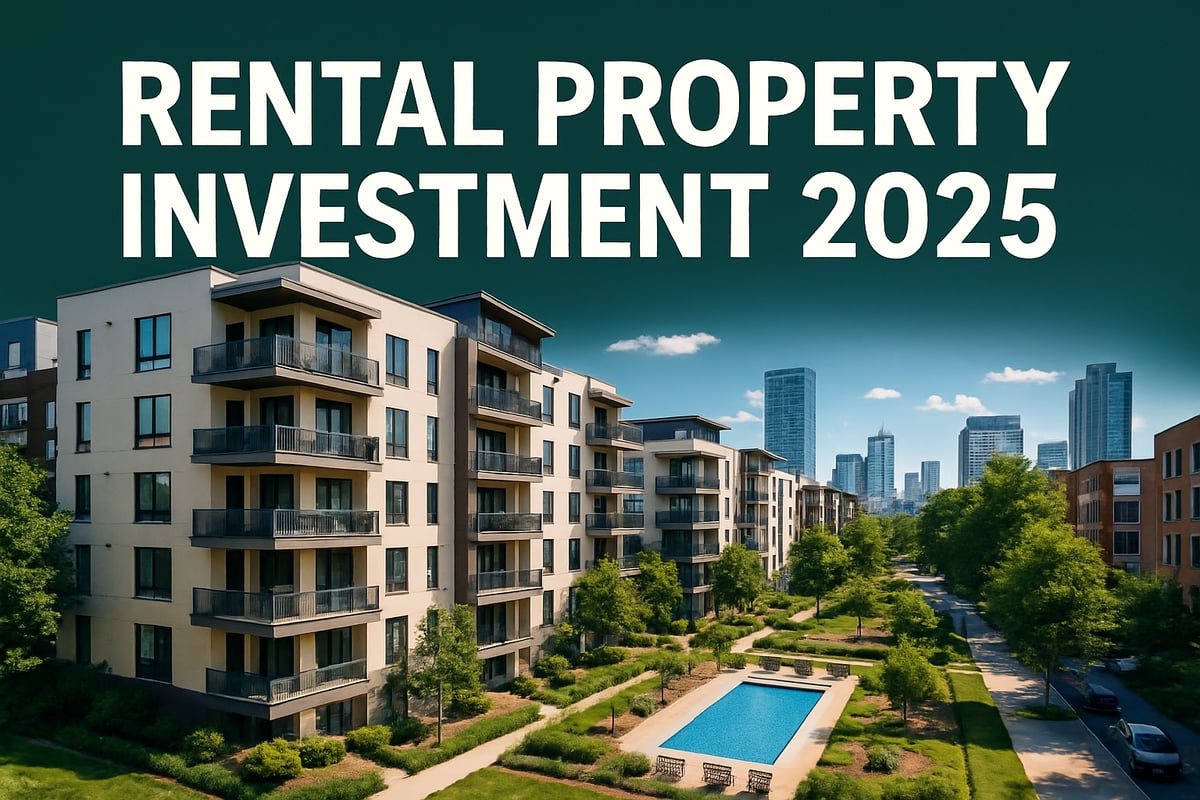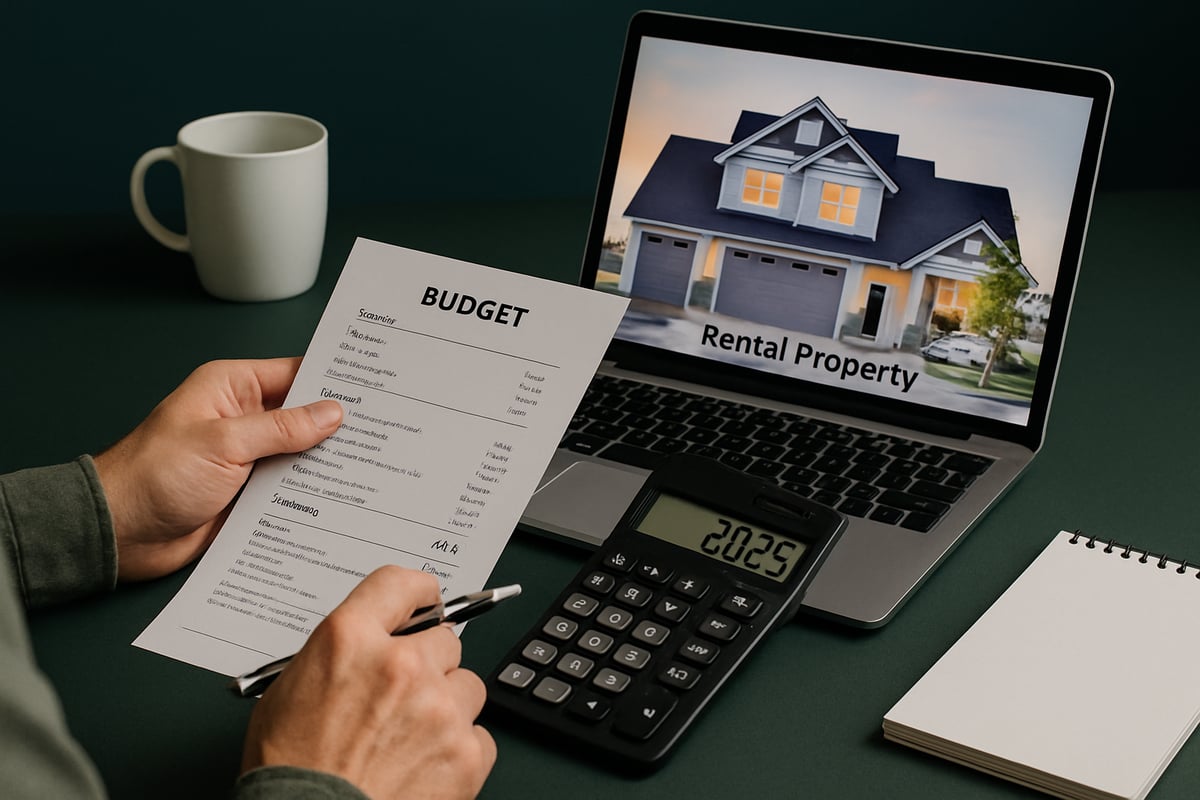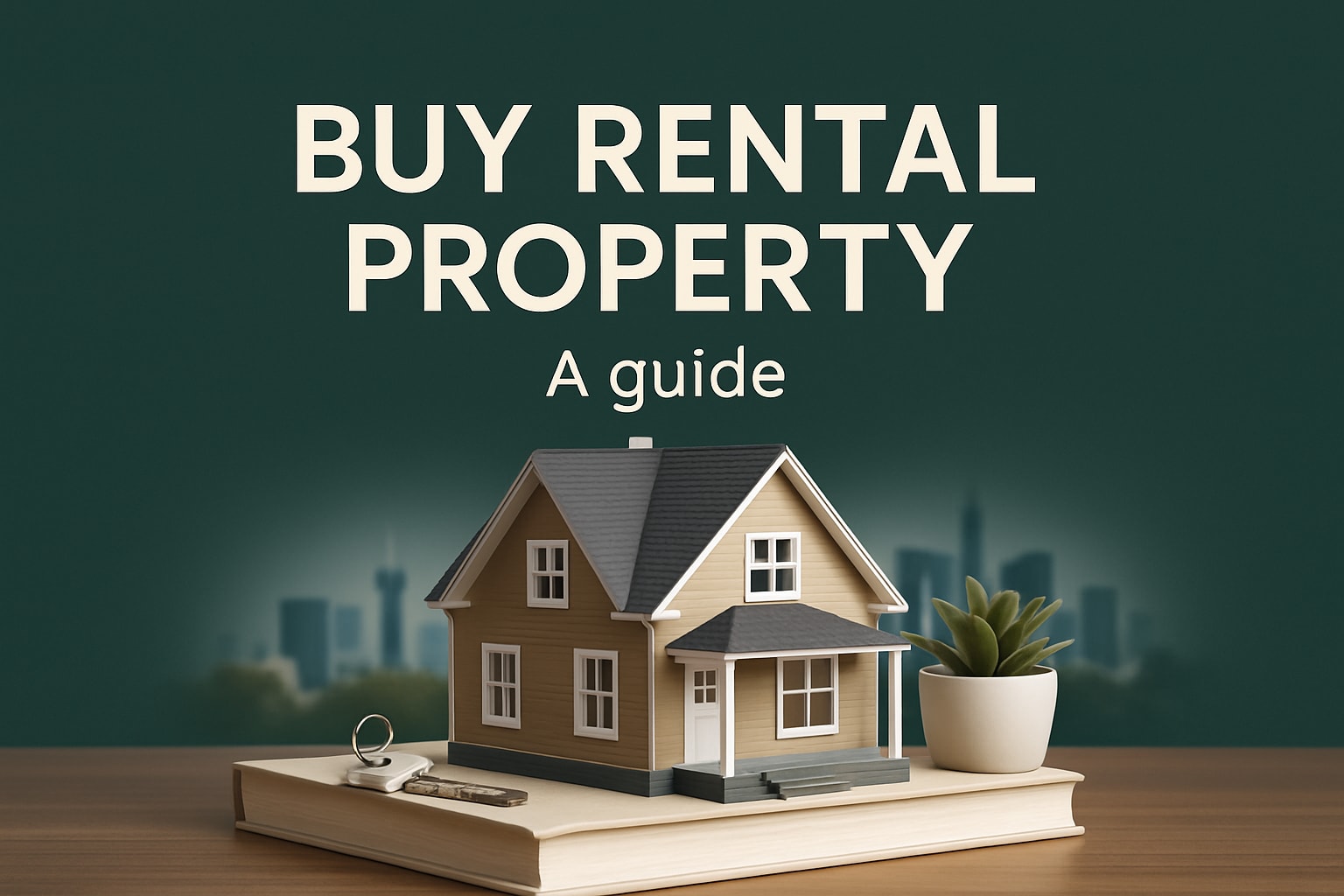Rental properties are gaining massive traction as a smart way to build wealth in 2025. With market optimism and shifting trends, more people are looking to buy rental property and tap into new opportunities for profit.
Whether you are exploring your first investment or expanding an established portfolio, this guide walks you through every essential step. You will learn about 2025 market trends, financial preparation, choosing the right property, financing options, legal considerations, and strategies to maximize returns.
Ready to make informed decisions and boost your investment success? Follow this guide to buy rental property with confidence in 2025.
Understanding the 2025 Rental Property Market
The 2025 real estate landscape is evolving rapidly, creating exciting new opportunities for those looking to buy rental property. Whether you’re a seasoned landlord or just starting out, understanding the current market is crucial for making smart investment decisions.

Key Market Trends and Forecasts
Demand for rental properties is projected to surge in 2025 as more millennials and Gen Z renters enter the market. This shift, combined with ongoing lifestyle changes and remote work trends, means many people are prioritizing flexibility over homeownership.
Rental prices are expected to grow steadily, fueled by limited housing supply and increased demand. According to Rocket Mortgage, vacancy rates in 2025 are forecast to range from 0.27% to 2.23%, reflecting a tight rental market in many regions. If you plan to buy rental property, these trends suggest strong income potential and low risk of prolonged vacancies.
Regional hot spots are emerging across the country, with secondary cities and suburbs seeing higher growth than some traditional urban centers. For instance, cities with tech hubs or strong job markets are attracting renters seeking affordability and quality of life. This creates more options for investors who want to buy rental property in up-and-coming areas.
Here’s a quick comparison of urban vs. suburban rental performance in 2025:
| Location Type | Avg. Vacancy Rate | Rental Price Growth | Renter Demographics |
|---|---|---|---|
| Urban | 1.3% | Moderate | Young professionals |
| Suburban | 0.8% | High | Families, remote workers |
Inflation and interest rates are also shaping the market. While higher rates may increase borrowing costs, rental rates often rise alongside inflation, helping investors maintain profitability. Keeping an eye on these trends will help you buy rental property that aligns with your financial goals.
For deeper insights on trends and maximizing returns, see the latest Rental Property Trends for Maximizing ROI in 2025.
Risks and Opportunities for Investors
Every investment comes with risks, and buying rental property is no exception. Market corrections can impact property values, while regulatory changes—like stricter rent controls or short-term rental restrictions—can affect profitability.
Tenant turnover is another risk. High turnover means more time and money spent on finding new renters. However, you can reduce this risk by focusing on properties in stable neighborhoods with strong demand.
Opportunities in 2025 are abundant. Short-term rentals, for example, can generate higher income in tourist-friendly areas. Multifamily units offer diversified income streams, while value-add properties let you increase rents through renovations or upgrades.
To successfully buy rental property, consider these risk mitigation strategies:
- Research local regulations before investing.
- Diversify your property portfolio across different types and locations.
- Build strong relationships with tenants to encourage long-term leases.
- Keep cash reserves for unexpected repairs or vacancies.
By understanding both the risks and opportunities, you can make informed decisions that help you buy rental property and build long-term wealth. Staying flexible and adapting to market changes will give you a competitive edge.
Setting Your Investment Goals and Strategy
Setting clear goals is the first step for anyone planning to buy rental property. Whether you want steady income, long-term growth, or to diversify your portfolio, your approach should match your unique situation. Let's break down how to clarify your investment purpose, choose the right property, and determine your budget for 2025.

Defining Your Investment Purpose
Before you buy rental property, ask yourself: What do I want to achieve? Some investors focus on monthly cash flow, while others look for long-term appreciation or simply want to diversify their assets.
Consider your available time. Do you want to be hands-on with property management, or would you rather hire professionals and take a more passive role? Assess your risk tolerance and how long you plan to hold the property.
For example, young professionals often prefer properties with higher appreciation potential, even if cash flow is lower at first. Retirees may lean toward stable, income-producing rentals to supplement their retirement. No matter your profile, aligning your goals with your strategy ensures your decision to buy rental property supports your financial future.
Choosing the Right Property Type
The type of property you select is crucial when you buy rental property. Single-family homes are popular for their simplicity and strong resale value, but multifamily properties can offer multiple income streams and lower vacancy risk.
Short-term rentals may yield higher returns in tourist areas but come with more management needs and possible regulations. Long-term leases are steadier but might bring lower monthly income. Fixer-uppers can be affordable entry points, though they require renovation skills and a larger upfront commitment. Turnkey properties are move-in ready but usually cost more.
Here's a quick comparison:
| Property Type | Pros | Cons |
|---|---|---|
| Single-family | Easy to manage, high demand | Slower income growth |
| Multifamily | More income sources | Complex management |
| Short-term rental | High potential ROI | Regulation, higher turnover |
| Turnkey | Immediate rental income | Higher purchase price |
| Fixer-upper | Lower entry cost | Renovation risks |
For a detailed breakdown, see Investment property types explained.
Matching property type to your goals is one of the smartest ways to buy rental property that fits your lifestyle and expectations.
Determining Your Budget and Financing Needs
Next, calculate how much you can afford to spend when you buy rental property. Start by estimating potential rental income and subtracting projected expenses such as mortgage payments, taxes, insurance, maintenance, and any HOA fees.
Use rental yield calculators and affordability tools to get an accurate picture. For instance, if you’re considering a $400,000 rental, a 20% down payment means you’ll need $80,000 upfront. Ongoing costs will include mortgage, annual taxes, and property management if you choose to be hands-off.
Budgeting tip: Always leave a buffer for unexpected repairs or vacancies. By understanding your numbers before you buy rental property, you’ll be better prepared to make confident, profitable decisions.
Financial Preparation: Budgeting, Loans, and Costs
Before you jump into the process to buy rental property, understanding your financial landscape is crucial. Let’s break down what you’ll need upfront, what costs to expect over time, and how to set yourself up for a smooth investment journey.

Calculating Upfront and Ongoing Costs
When you buy rental property, the first step is calculating both upfront and recurring expenses. Most lenders in 2025 will require a down payment of 15% to 20% for investment properties. For a $400,000 home, that’s $60,000 to $80,000 upfront.
You’ll also face closing costs, which typically range from 2% to 5% of the purchase price. Don’t forget inspection and appraisal fees—these are essential to avoid costly surprises. Once you own the property, ongoing costs stack up: mortgage payments, property taxes (0.27%–2.23% annually), insurance, and maintenance (typically 1%–3% of property value per year).
Here’s a quick breakdown for a $400,000 property:
| Expense Type | Amount (Annual/Upfront) |
|---|---|
| Down Payment | $60,000–$80,000 |
| Closing Costs | $8,000–$20,000 |
| Property Taxes | $1,080–$8,920 |
| Insurance | $1,500–$2,500 |
| Maintenance | $4,000–$12,000 |
| HOA Fees | Varies |
Decide who pays utilities—tenant or landlord—as this affects your net income. If you buy rental property in an HOA community, factor in those fees as well.
Exploring Financing Options
Financing is a key part of any plan to buy rental property. Most investors use conventional loans, which require higher down payments and stricter credit standards. Government-backed loans like FHA and VA are generally reserved for owner-occupied homes, so they’re less useful for pure investment.
If you already own a home, consider leveraging your equity with a HELOC or a cash-out refinance. These can provide flexible funding for your next buy rental property opportunity. Creative solutions, such as partnerships, co-borrowers, or even assumable mortgages, may help if you’re facing barriers with traditional lenders.
To stay ahead, keep an eye on interest rates and inflation trends. For more insights, check out Top 5 Real Estate Investment Strategies for 2025, which covers ways to finance and hedge your investment.
Let’s look at a quick example: Using a HELOC with $100,000 available, you could cover the down payment for a $400,000 property, leaving your cash reserves intact. This approach can open doors for more deals when you’re ready to buy rental property.
Getting Preapproved and Strengthening Your Application
Getting preapproved is essential before you buy rental property. Preapproval shows sellers you’re serious and speeds up your offer process. Lenders will review your credit score, debt-to-income ratio, and financial documents, so it pays to prepare.
Boost your credit score by paying down debts and correcting any errors on your report. Aim for a debt-to-income ratio below 43% for the best rates. Gather documents like:
- Recent pay stubs or proof of income
- Bank and investment statements
- Tax returns from the past two years
- Details on current debts and assets
The preapproval timeline can vary, but with all paperwork in order, you could be ready to make offers within a week. Remember, a strong application increases your chances to buy rental property in a competitive market.
Step-by-Step Process to Buy a Rental Property in 2025
Navigating how to buy rental property in 2025 might seem overwhelming, but breaking it down into clear steps makes the journey manageable. This section walks you through the key stages, from researching locations to getting your property ready for tenants. By following this process, you’ll set yourself up for a successful rental investment.

1. Research and Select the Right Location
The first step when you buy rental property is choosing a location with strong rental demand and growth prospects. Analyze factors like neighborhood safety, proximity to schools, transport links, and amenities. Use recent rental market data to compare average rents and vacancy rates across different cities.
For example, consider this table comparing two popular cities for investment:
| City | Avg. Rent | Vacancy Rate | Growth Potential |
|---|---|---|---|
| City A | $2,100 | 1.2% | High |
| City B | $1,800 | 2.0% | Moderate |
Look for emerging hot spots where remote work trends are boosting demand. Demographics matter too—areas popular with millennials or Gen Z renters often see low vacancies.
Before you buy rental property, review regional trends and tap into resources like Home rental investment strategies for deeper insights on picking the right market.
2. Identify and Evaluate Potential Properties
Once you’ve narrowed down your location, the next step to buy rental property is to identify and assess individual properties. Review listings for single-family homes, multifamily units, condos, or vacation rentals. Prioritize properties in good condition to minimize upfront renovation costs.
Inspect each property carefully. Look for signs of structural issues, outdated systems, or needed upgrades. A professional inspection can reveal hidden problems. Calculate your expected rental income and compare it with projected expenses to estimate cash flow.
Here’s a simple cash flow formula:
Monthly Cash Flow = Expected Rent - (Mortgage + Taxes + Insurance + Maintenance)
For example, if your expected rent is $2,200 and total monthly costs are $1,700, your monthly cash flow is $500. This step is crucial to ensure your plan to buy rental property leads to sustainable returns.
3. Make an Offer and Negotiate Terms
When you’re ready to buy rental property, crafting a compelling offer is key. In a competitive market, consider offering a quick closing or a larger earnest deposit to stand out. Work closely with your real estate agent to structure your offer to include contingencies for inspection and financing.
Negotiation is part art, part strategy. Here are some tips:
- Know the seller’s motivation (quick sale, price, flexibility)
- Be prepared to walk away if the terms don’t fit your goals
- Use inspection findings as leverage for price adjustments or repair credits
For instance, if an inspection uncovers HVAC issues, you could request a $3,000 credit or ask the seller to repair it before closing. Stay calm and focused on your investment goals throughout the negotiation process.
4. Secure Financing and Finalize the Deal
After your offer is accepted, the next phase to buy rental property involves securing your financing. Submit your loan application and provide all requested documents promptly. The lender will order an appraisal to confirm the property value, and a home inspection may be scheduled.
If the appraisal comes in lower than your offer, you may need to renegotiate the price or cover the gap with a larger down payment. Address any inspection issues upfront, whether by negotiating repairs or adjusting your offer.
Keep communication open with your lender and agent to avoid delays. Once underwriting is complete and all contingencies are cleared, you’ll receive the “clear to close” and can prepare for the final steps.
5. Close on the Property and Prepare for Tenants
The final step to buy rental property is closing and prepping for tenants. Review the closing disclosure, sign required documents, and make your final payment. Once the deal is complete, set up utilities, arrange for property insurance, and either self-manage or hire a property manager.
Before renting out your property, complete repairs, deep cleaning, and compliance checks (like smoke detectors and local safety codes). Use this checklist to get ready:
- Change locks and rekey doors
- Test all appliances and systems
- Clean carpets, floors, and common areas
- Take marketing photos for listings
With these steps, you’ll be ready to welcome your first tenants and start generating income from your new investment.
Legal, Tax, and Regulatory Considerations for Landlords
Navigating the legal and tax landscape is essential when you buy rental property. Understanding your rights and obligations as a landlord in 2025 will help you avoid costly mistakes and maximize your returns.
Understanding Landlord-Tenant Laws
When you buy rental property, staying compliant with landlord-tenant laws is crucial. In 2025, lease agreements must clearly outline rent terms, security deposit rules, and repair responsibilities. Security deposit regulations often limit the amount you can collect and specify how quickly you must return it after a tenant leaves.
Eviction procedures are evolving, with more emphasis on mediation and notice periods. The Fair Housing Act still prohibits discrimination based on race, gender, religion, or disability, so your tenant selection process must be fair and consistent. Local ordinances may also impact your rental, especially if you offer short-term leases or operate in areas with rent control.
Common legal pitfalls include mishandling deposits, failing to provide required disclosures, or not maintaining the property to code. Reviewing local laws before you buy rental property protects your investment and reputation.
Tax Implications and Benefits
Understanding taxes is vital when you buy rental property. Rental income is taxable, but you can deduct many expenses, such as mortgage interest, repairs, insurance, and even depreciation. These deductions reduce your taxable income, often resulting in substantial savings.
Capital gains tax applies if you sell a property for a profit, but strategies like 1031 exchanges can help defer these taxes. Good record-keeping is essential—track all expenses and receipts to ensure you claim every allowable deduction.
For a deeper dive into what you can claim, check out these tax breaks on investment property. By planning ahead, you can turn tax rules into an advantage when you buy rental property.
Insurance and Liability Protection
Insurance is a must when you buy rental property. Standard landlord insurance typically covers the building, liability for injuries, and sometimes loss of rental income if the property becomes uninhabitable. This coverage protects you from unexpected events like fire, storms, or vandalism.
Consider optional policies for added protection, such as coverage for legal expenses or tenant-caused damages. Liability insurance is especially important, as accidents can happen and lawsuits are costly.
Requiring tenants to have renters insurance can also limit your exposure. By securing the right insurance, you shield yourself from risks and ensure your buy rental property journey is safe and profitable.
Maximizing Rental Property ROI and Ongoing Management
Maximizing returns after you buy rental property is just as important as making a smart purchase. Effective management, smart upgrades, and strategic planning can turn a good investment into a great one.
Setting the Right Rent and Attracting Tenants
Setting the right rent is crucial when you buy rental property. Start by researching local market rents for similar properties. Compare features, square footage, and amenities to determine a competitive rate.
To attract quality tenants, use multiple marketing strategies:
- List your property on top rental platforms and social media
- Use professional photos and virtual tours
- Stage the property to highlight its best features
Screen tenants thoroughly. Run credit, background, and reference checks to minimize risk. A well-placed ad and careful screening reduce vacancy and help you maintain steady income after you buy rental property.
Vacancy can be costly. Respond promptly to inquiries, offer flexible viewing times, and consider incentives like a free month’s rent to fill units faster.
Managing Property Operations
Deciding how to manage your property is key after you buy rental property. You can handle everything yourself or hire a property manager. Here’s a quick comparison:
| Aspect | Self-Management | Property Manager |
|---|---|---|
| Cost | Time-intensive, no fee | 8–12% of rental income |
| Control | Full control over decisions | Manager handles day-to-day |
| Maintenance | DIY or hire contractors | Manager coordinates repairs |
| Tenant Relations | Direct communication | Manager screens and communicates |
Self-managing gives you more control but requires time and effort. A property manager can save time, especially if you own multiple units or live far away. Whichever route you choose when you buy rental property, set clear processes for collecting rent, handling late payments, and responding to maintenance requests.
Routine maintenance is essential. Schedule regular inspections and respond quickly to issues to keep tenants happy and protect your investment.
Enhancing Property Value and Cash Flow
Once you buy rental property, focus on upgrades that boost both value and rental income. Prioritize renovations with high ROI, such as kitchen and bathroom updates, or improving curb appeal.
Consider these value-adding improvements:
- Energy-efficient appliances and smart thermostats
- Fresh paint and modern fixtures
- Landscaping for better curb appeal
Reducing expenses also boosts cash flow. Shop around for insurance, negotiate service contracts, and invest in preventative maintenance.
For example, upgrading an outdated kitchen for $8,000 could allow you to increase rent by $150 per month, adding $1,800 in annual income. Over several years, this more than covers the renovation cost.
For more actionable ideas, check out 5 Strategies For Maximizing ROI From Rental Properties In 2025, which covers innovative approaches to increase returns after you buy rental property.
Planning for Growth and Scaling Your Portfolio
After you buy rental property and master ongoing management, you may want to expand your portfolio. Reinvesting profits is a common approach. Many investors use 1031 exchanges to defer capital gains taxes while trading up to bigger or better properties.
Building a strong team is essential as you grow:
- Real estate agents for sourcing new deals
- Accountants for tax planning
- Contractors for reliable repairs and upgrades
A typical scaling timeline might look like this:
- Year 1: Buy first rental property, establish systems
- Year 2–3: Reinvest profits, buy additional units
- Year 4+: Use equity and tax strategies for further expansion
By following these steps, you can turn a single property into a robust income stream and long-term wealth.
Now that you know what it takes to succeed with rental property in 2025, it is time to put those insights into action. Whether you are figuring out your goals, comparing properties, or just want to make the smartest move with your superannuation, you do not have to do it alone. We are here to help you find the right investment that fits your future plans and retirement dreams. If you are ready to take the next step and start building your wealth, let us guide you every step of the way. Start Building Your Wealth—Speak With an Expert




